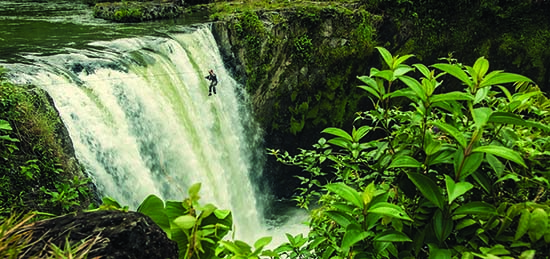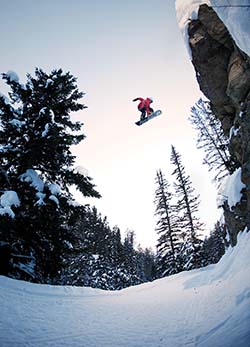 |
 |
| current issue |  |
past issues |  |
send a letter/news |  |
address update |  |
advertise |  |
about us |  |
alumni home |
Going to Extremes
Page 3 of 4
Previous | Next
Still, the setup, at least from a personal safety perspective, was not ideal. Kemple's anchor wasn't optimal, and there was a tiny little voice inside his head that reminded him of this. "I've been in a lot of crazy locations in order to capture moments on film, but being suspended over the waterfall was likely the craziest," he admits. He was so uncertain of the end of the line tied off to a boulder that he went out the first time with a helmet and life vest on. "You don't know if this thing is going to hold," he says. "And then we put two people on the line and you're like, 'Geez, this is really stupid.' " Kemple says the sensation of hanging above the abyss with avalanching whitewater rushing toward him was unlike anything he'd ever felt before. "I kept looking up because if you stared straight ahead continuously, you'd get this vertigo. Everything around you is moving, but you're just kind of sitting still. Your equilibrium expects you to be moving too." Another equilibrium-jarring moment occurred when he was shooting the acclaimed British rock climber James Pearson. It was nearing sunset, and Pearson was scaling the sheer vertical limestone sea cliffs of Mallorca, rope-free, in a sport called deep-water soloing. Kemple was roped up in the unseen foreground, his assistant operating a remote flash while clipped in farther down the line. Pearson is captured losing his grip and falling 50 feet into the dark water below. The climbing chalk coming off his outstretched hands looks like contrails. Pearson's shirtless back is to the camera, making it appear that Kemple is shooting from another elaborately suspended vantage point out in the Mediterranean. In fact, he had rappelled 10 feet down the face and leaned precipitously out. "It was James' idea to fall 50 feet into water," says Kemple. "I said, 'Are you sure?' "
When I asked Kemple if it's hard to find help given the dangerous places he goes—not to mention his preference for shooting on days "when it's raining, snowing, windy, or about to storm"—he says, no, just the opposite. He gets a steady stream of emails from amateur photographers hoping to join him on whatever adventure he's planning next. That interest is only liable to grow with the avalanche of recognition coming Kemple's way. He has been featured in National Geographic and Outside, and is a frequent contributor to high-profile outdoor companies like The North Face and Eastern Mountain Sports. The rock-star collective that he helped found—the Camp 4 Collective (named for the famous climbing site at Yosemite)—is made up of four of the best young adventure photographers in the outdoor world, each of whom produce both film and still images. For Kemple, working with like-minded photographers keeps him motivated, each pushing the other to explore using technique, craft, and their own extraordinary "personal hardiness." As he told National Geographic, "We are no longer viewing 'the never seen before' but instead 'the never seen before this way.'" Creativity, he says, is increasingly more important than documentation. |
blog comments powered by Disqus



